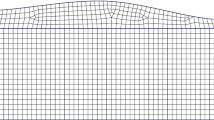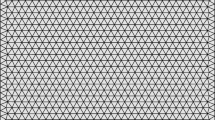Abstract
The discontinuous Galerkin (DG) method is an established method for computing approximate solutions of partial differential equations in many applications. Unlike continuous finite elements, in DG methods numerical fluxes are used to enforce inter-element conditions, and internal/external physical boundary conditions. For elastic wave propagation in complex media several wave types, including dissipative surface and interface waves, are simultaneously supported. The presence of multiple wave types and different physical phenomena pose a significant challenge for numerical fluxes. When modelling surface or interface waves an incompatibility of the numerical flux with the physical boundary condition leads to numerical artefacts. We present a stable and arbitrary order accurate DG method for elastic waves with a physically motivated numerical flux. Our numerical flux is compatible with all well-posed, internal and external, boundary conditions, including linear and nonlinear frictional constitutive equations for modelling spontaneously propagating shear ruptures in elastic solids and dynamic earthquake rupture processes. By construction our choice of penalty parameters yield an upwind scheme and a discrete energy estimate analogous to the continuous energy estimate. We derive a priori error estimate for the DG method proving optimal convergence to discontinuous and nearly singular exact solutions. The spectral radius of the resulting spatial operator has an upper bound which is independent of the boundary and interface conditions, thus it is suitable for efficient explicit time integration. We present numerical experiments in one and two space dimensions verifying high order accuracy and asymptotic numerical stability. We demonstrate the potential of the method for modelling complex nonlinear frictional problems in elastic solids with 2D dynamically adaptive meshes and non-planar topography with 2D curvilinear elements.










Similar content being viewed by others
References
Aki, K., Richards, P.G.: Quantitative Seismology. University Science Books, Sausalito (2002)
Ampuero, J.P., Ben-Zion, Y.: Cracks, pulses and macroscopic asymmetry of dynamic rupture on a bimaterial interface with velocity-weakening friction. Geophys. J. Int. 173, 674–692 (2008)
Andrews, D.J.: Dynamic plane-strain shear rupture with a slip-weakening friction law calculated by a boundary integral method. Bull. Seismol. Soc. Am. 75, 1–21 (1985)
Burstedde, C., Wilcox, L.C., Ghattas, O.: p4est: Scalable algorithms for parallel adaptive mesh refinement on forests of octrees. SIAM J. Sci. Comput. 33, 1103–1133 (2011)
Canuto, C., Hussaini, M.Y., Quarteroni, A., Zang, T.A.: Spectral Methods: Fundamentals in Single Domains. Springer, Berlin (2006)
Chaljub, E., Moczo, P., Tsuno, S., Bard, P.Y., Kristek, J., Käser, M., Stupazzini, M., Kristekova, M.: Quantitative comparison of four numerical predictions of 3d ground motion in the Grenoble valley, France. Bull. Seismol. Soc. Am. 100, 1427–1455 (2010)
Chan, J., Warburton, T.: On the penalty stabilization mechanism for upwind discontinuous Galerkin formulations of first order hyperbolic systems. Comput. Math. Appl. 74, 3099–3110 (2017)
Cockburn, B., Hou, S., Shu, C.W.: The Runge–Kutta local projection discontinuous Galerkin finite element method for conservation laws IV. J. Comput. Phys. 54, 545–581 (1990)
Cockburn, B., Shu, C.W.: TVB Runge–Kutta local projection discontinuous Galerkin finite element method for conservation laws II: general framework. Math. Comput. 52, 411–435 (1989)
De Grazia, D., Mengaldo, G., Moxey, D., Vincent, P.E., Sherwin, S.: Connections between the discontinuous Galerkin method and high-order flux reconstruction schemes. Int. J. Numer. Methods Fluids 00, 1–18 (2013)
de la Puente, J., Ampuero, J.-P., Käser, M.: Dynamic rupture modeling on unstructured meshes using a discontinuous Galerkin method. J. Geophys. Res. 114, B10302 (2009)
Dumbser, M., Käser, M.: An arbitrary high-order discontinuous Galerkin method for elastic waves on unstructured meshes—I. The two-dimensional isotropic case with external source terms. Geophys. J. Int. 166, 855–877 (2006)
Dumbser, M., Käser, M.: An arbitrary high-order discontinuous Galerkin method for elastic waves on unstructured meshes–II. The three-dimensional isotropic case. Geophys. J. Int. 167, 319–336 (2006)
Dumbser, M., Peshkov, I., Romenski, E., Zanotti, O.: High order ADER schemes for a unified first order hyperbolic formulation of continuum mechanics: viscous heat-conducting fluids and elastic solids. J. Comput. Phys 5, 824–862 (2016)
Duru, K., Dunham, E.M.: Dynamic earthquake rupture simulations on nonplanar faults embedded in 3d geometrically complex, heterogeneous elastic solids. J. Comput. Phys. 305, 185–207 (2016)
Duru, K., Kreiss, G., Mattsson, K.: Accurate and stable boundary treatment for the elastic wave equations in second order formulation. SIAM J. Sci. Comput. 36, A2787–A2818 (2014)
Duru, K., Rannabauer, L., Ling, O.K.A., Gabriel, A.-A., Igel, H., Bader, M.: A stable discontinuous galerkin method for linear elastodynamics in geometrically complex media using physics based numerical fluxes (2019). arXiv:1907.02658
Gabriel, A.-A., Chiocchetti, S., Li, D., Tavelli, M., Peshkov, I., Evgeniy, R., Dumbser, M.: A unified first order hyperbolic model for nonlinear dynamic rupture processes in diffuse fracture zones. Philos. Trans. R. Soc. A 379, 1–18 (2021)
Geubelle, P.H., Rice, J.R.: A spectral method for three dimensional elastodynamic fracture problems. J. Mech. Phys. Solids 43, 1791–1824 (1995)
Godunov, S.K.: A difference method for numerical calculation of discontinuous solutions of the equations of hydrodynamics. Mat. Sb. 181, 271–306 (1959)
Gustafsson, B., Kreiss, H.-O., Oliger, J.: Time Dependent Problems and Difference Methods. Wiley, New York (1995)
Harris, R.A., et al.: A suite of exercises for verifying dynamic earthquake rupture codes. Seismol. Res. Lett. 89, 1146–1162 (2018)
Heinecke, A., Rettenberger, S., Breuer, A., Bader, M., Gabriel, A.-A., Pelties, C., Liao, X-K., Bode, A., Barth, W., Vaidyanathan, K., Smelyanskiy, M., Dubey, P.: Petascale high order dynamic rupture earthquake simulations on heterogeneous supercomputers. In: Proceedings of SC 2014 New Orleans, LA (2014)
Hesthaven, J., Warburton, T.: Nodal Discontinuous Galerkin Methods: Algorithms, Analysis, and Applications. Springer, New York (2008)
Hesthaven, J.S., Warburton, T.: Nodal high-order methods on unstructured grids: I. Time-domain solution of Maxwell’s equations. J. Comput. Phys. 181, 186–221 (2002)
Huynh, H.T.: A flux reconstruction approach to high-order schemes including discontinuous Galerkin methods. In: 18th AIAA Computational Fluid Dynamics Conference, Fluid Dynam-ics and Co located Conferences https://doi.org/10.2514/6.2007-4079 (2007)
Kaneko, Y., Lapusta, N., Ampuero, J.-P.: Spectral element modeling of spontaneous earthquake rupture on rate and state faults: effect of velocity-strengthening friction at shallow depths. J. Geophys. Res. 113, B09317 (2008)
Kirby, R.M., Karniadakis, G.E.: Selecting the numerical flux in discontinuous Galerkin methods for diffusion problems. J. Sci. Comput. 22, 385–411 (2005)
Kopriva, D.A., Gassner, G.J.: An energy stable discontinuous Galerkin spectral element discretization for variable coefficient advection problems. SIAM J. Sci. Comput. 36, A2076–A2099 (2014)
Kopriva, D.A., Nordström, J., Gassner, G.J.: Error boundedness of discontinuous Galerkin spectral element approximations of hyperbolic problems. J. Sci. Comput. 72, 314–330 (2017)
Kreiss, H.-O., Oliger, J.: Comparison of accurate methods for the integration of hyperbolic equations. Tellus 24, 199–215 (1972)
Kreiss, H.-O., Petersson, N.A., Yström, J.: Accurate and stable boundary treatment for the elastic wave equations in second order formulation. SIAM J. Numer. Anal. 40, 1940–1967 (2020)
Krischer, L., et al.: Seismo-live: an educational online library of Jupyter notebooks for seismology. Seismol. Res. Lett. 89, 2413–2419 (2018)
Pelties, C., de la Puente, J., Ampuero, J.-P., Brietzke, G.B., Käser, M.: Three-dimensional dynamic rupture simulation with a high-order discontinuous Galerkin method on unstructured tetrahedral meshes. J. Geophys. Res. 117, B02309 (2012)
Pelties, C., Gabriel, A.-A., Ampuero, J.-P.: Verification of an ADER-DG method for complex dynamic rupture problems. Geosci. Model Dev. 7, 847–866 (2014)
Qiu, J.: Development and comparison of numerical fluxes for LWDG methods. Numer. Math. Theor. Methods Appl. 1, 435–459 (2008)
Ramos, M.D., Huang, Y.: How the transition region along the Cascadia megathrust influences coseismic behavior: insights from 2-D dynamic rupture simulations. Geophys. Res. Lett. 46, 1973–1983 (2019)
Rayleigh, L.: On waves propagated along the plane surface of an elastic solid. Proc. Lond. Math. Soc. 17, 4–11 (1885)
Reed, W.H., Hill, T.R.: Triangular mesh methods for the neutron transport equation. Technical Report LA-UR-73-479, Los Alamos National Laboratory, Los Alamos, New Mexico, USA (1973)
Reinarz, A., Charrier, D.E., Bader, M., Bovard, L., Dumbser, M., Fambri, F., Duru, K., Gabriel, A.-A., Gallard, J.-M., Köppel, S., Krenz, L., Rannabauer, L., Rezzolla, L., Samfass, P., Tavelli, M., Weinzierl, T.: Exahype: an engine for parallel dynamically adaptive simulations of wave problems. Comput. Phys. Commun. 254, 107251 (2020)
Rice, J.R.: Constitutive relations for fault slip and earthquake instabilities. J. Appl. Mech. 50, 443–475 (1983)
Rice, J.R., Ruina, A.L.: Stability of steady frictional slipping. J. Appl. Mech. 50, 343–349 (1983)
Rusanov, V.V.: Calculation of interaction of non-stationary shock waves with obstacles. J. Comput. Math. Phys. USSR 1, 267–279 (1961)
Scholz, C.H.: Earthquakes and friction laws. Nature 391, 37–42 (1998)
Tavelli, M., Chiocchetti, S., Romenski, E., Gabriel, A.-A., Dumbser, M.: Space-time adaptive ADER discontinuous Galerkin schemes for nonlinear hyperelasticity with material failure. J. Comput. Phys. 422, 109758 (2020)
Titarev, V.A., Toro, E.F.: ADER: arbitrary high order Godunov approach. J. Sci. Comput. 17, 609–618 (2002)
Ulrich, T., Madden, E.H., Gabriel, A.-A.: Stress, rigidity and sediment strength control megathrust earthquake and tsunami dynamics. EarthArxiv preprint (2020)
Uphoff, C., Rettenberger, S., Bader, M., Wollherr, S., Ulrich, T., Madden, E.M., Gabriel, A.-A.: Extreme scale multi-physics simulations of the tsunamigenic 2004 sumatra megathrust earthquake (2017)
Warburton, T.: A low storage curvilinear discontinuous Galerkin method for wave problems. SIAM J. Sci. Comput. 35, A1987–A2012 (2013)
Weinzierl, T., Mehl, M.: Peano—a traversal and storage scheme for octree-like adaptive cartesian multiscale grids. SIAM J. Sci. Comput. 33, 2732–2760 (2011)
Wilcox, L.C., Stadler, G., Burstedde, C., Ghattas, O.: A high-order discontinuous Galerkin method for wave propagation through coupled elastic-acoustic media. J. Comput. Phys. 229, 9373–9396 (2010)
Wolf, S., Gabriel, A.-A., Bade, M.: Optimisation and local time stepping of an ADER-DG scheme for fully anisotropic wave propagation in complex geometries 32–45 https://doi.org/10.1007/978-3-030-50420-5_3 (2020)
Wollherr, S., Gabriel, A.-A., Mai, P.M.: Landers 1992 “reloaded”: Integrative dynamic earthquake rupture modeling. J. Geophys. Res. 124, 6666–6702 (2019)
Acknowledgements
We thank the anonymous reviewers and Editor-in-Chief Chi-Wang Shu for constructive criticism which significantly improved the clarity and quality of the manuscript. The work presented in this paper was enabled by funding from the European Union’s Horizon 2020 research and innovation program under Grant Agreements Nos. 671698 (ExaHyPE), 852992 (TEAR) and 823844 (ChEESE). A.-A.G. acknowledges additional support by the German Research Foundation (DFG) (Projects Nos., GA 2465/2-1, GA 2465/3-1), by KONWIHR—the Bavarian Competence Network for Technical and Scientific High Performance Computing (project NewWave), and by KAUST-CRG (FRAGEN, Grant No. ORS-2017-CRG6 3389.02).
Author information
Authors and Affiliations
Corresponding author
Additional information
Publisher's Note
Springer Nature remains neutral with regard to jurisdictional claims in published maps and institutional affiliations.
Rights and permissions
About this article
Cite this article
Duru, K., Rannabauer, L., Gabriel, AA. et al. A New Discontinuous Galerkin Method for Elastic Waves with Physically Motivated Numerical Fluxes. J Sci Comput 88, 51 (2021). https://doi.org/10.1007/s10915-021-01565-1
Received:
Revised:
Accepted:
Published:
DOI: https://doi.org/10.1007/s10915-021-01565-1
Keywords
- Elastic wave equation
- First order systems
- Boundary conditions
- Interface conditions
- Nonlinear friction laws
- Stability
- Discontinuous Galerkin method
- Spectral accuracy
- Penalty method




